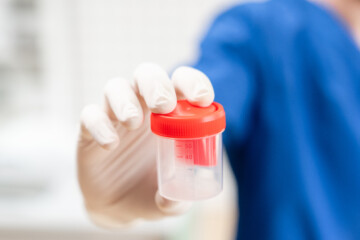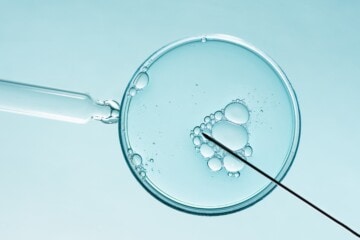That’s why we’ve put together a list of some common myths associated with male infertility.
Myth 1 – Infertility is a female issue
This particular myth goes back centuries and centuries.
The truth, however, is that 40% of fertility problems are due to men, 40% are due to women, and the remaining 20% are due to both sexes or unknown reasons.
So, how common is male infertility?
Well, an estimated 7% of all men are affected by infertility issues. Some 10-15% of infertile men have a complete lack of sperm, while others have problems with the quantity, movement or structure of their sperm. Others still have issues with ejaculation, impotence and testosterone production.
Myth 2 – The man’s age is not important
Some men can conceive when they’re in their 60s or 70s. This simply isn’t biologically possible for most women, whose chances of conceiving diminish rapidly as the quality of their eggs drops in their 40s.
However, there are no longer any doubts that male fertility declines with age.
One of the biggest factors is a reduction in sperm quantity and quality in older men. In one study involving men aged 55 or above, sperm motility was 54% lower than in men aged 30-35.
Sperm DNA damage is another consideration. More common in older men, it both reduces the chance of fertilisation and increases the chances of miscarriages.
Although less absolute than in the case of women, a man’s age does have a bearing on a couple’s chances of having a child.
Myth 3 – Lifestyle has no effect on fertility
Well, this certainly is not true. Lifestyle choices have a huge impact on fertility. Smoking, drinking alcohol and following a poor diet are all factors that can adversely affect your fertility.
Smoking, for example, has been shown to cause sperm DNA damage. But as well as giving up smoking, there are various lifestyle changes you can make to increase your chances of having children.
For example, exercise has been found to result in higher semen quality and testosterone levels, with testosterone being central to producing semen in the first place.
Myth 4 – Weight does not affect a man’s fertility
Sperm count and sperm morphology – the size, structure and shape of your sperm – are both affected by a man’s weight, according to studies comparing men with different BMIs.
In the past 30 years, male obesity in reproductive-age men has nearly tripled. This worrying statistic coincides with an increase in male infertility worldwide: global sperm concentration has halved in the last 40 years.
Myth 5 – The only solution to male infertility is getting a sperm donor
We’re fortunate to live in a time when science has a better understanding of infertility – and how to increase the chances of having a baby. In the majority of cases a sperm donor is not necessary.
However, too many people still believe that it’s the only answer if a male has fertility issues.
Experts have now identified many factors that contribute to male infertility, including stress, heat, smoking, diet and more.
For example, some men have an epididymal blockage, which prevents sperm from being ejaculated normally. In such a case, surgical extraction can be a viable solution.
Other men have problems with the movement or structure of their sperm, meaning their sperm can’t reach an egg or manage to fertilise it. These men will frequently achieve success through in vitro fertilisation (IVF), using their own sperm to conceive with their partner, often using a technique called ICSI (Intra-Cytoplasmic Sperm Injection), where a single sperm is injected directly into the cytoplasm of the egg. Supplementation with things such as Impryl can also considerably improve some of these sperm quality issues and support successful conception.
Should it be necessary to conceive using a sperm donor, it
is now much easier to do and more effective than it once was.
Hopefully, we’ve managed to banish some of the long-standing myths around male infertility. Now you can concentrate on the factors that do make a difference. From taking helpful micronutrients like Impryl to leading a healthier lifestyle, there are plenty of positive steps you can take to improve your fertility.
—————————————————-
References
World Health Organization (WHO) (2010). WHO laboratory Manual for the examination of human semen and sperm-cervical mucus interaction. Cambridge Academic Press.
Levitas E et al. Relationship between age and semen parameters in men with normal sperm concentration: analysis of 6022 semen. 5 April 2007.
Massányi P. Effects of Cadmium, Lead, and Mercury on the Structure and Function of Reproductive Organs. Toxics. 2020 Dec; 8(4): 94. Published online 2020 Oct 29. doi: 10.3390/toxics8040094.
Vaamonde, Diana et al. Physically active men show better semen parameters and hormone values than sedentary men. Eur J Appl Physiol. 2012 Sep;112(9):3267-73. doi: 10.1007/s00421-011-2304-6. Epub 2012 Jan 11.
Agarwal A et al. Effect of oxidative stress on male reproduction. World J Mens Health. 2014 Apr;32(1):1-17. doi: 10.5534/wjmh.2014.32.1.1. Epub 2014 Apr 25.
Sharma RK et al. Role of reactive oxygen species in male infertility. Urology. 1996 Dec;48(6):835-50. doi: 10.1016/s0090-4295(96)00313-5.
Ahmadi S et al. Antioxidant supplements and semen parameters: An evidence based review. Int J Reprod Biomed. 2016 Dec; 14(12): 729–736.
Torres-Arce E et al. Dietary Antioxidants in the Treatment of Male Infertility: Counteracting Oxidative Stress. Biology (Basel). 2021;10(3).
Tsao CW et al. Exploration of the association between obesity and semen quality in a 7630 male population. PLoS One. 2015 Mar 30;10(3):e0119458. doi: 10.1371/journal.pone.0119458. eCollection 2015.
Palmer NO et al. Impact of obesity on male fertility, sperm function and molecular composition. Spermatogenesis. 2012 Oct 1;2(4):253-263. doi: 10.4161/spmg.21362.
Levine H et al. Temporal trends in sperm count: a systematic review and meta-regression analysis of samples collected globally in the 20th and 21st centuries. Human Reproduction Update, Volume 29, Issue 2, March-April 2023, Pages 157–176.








